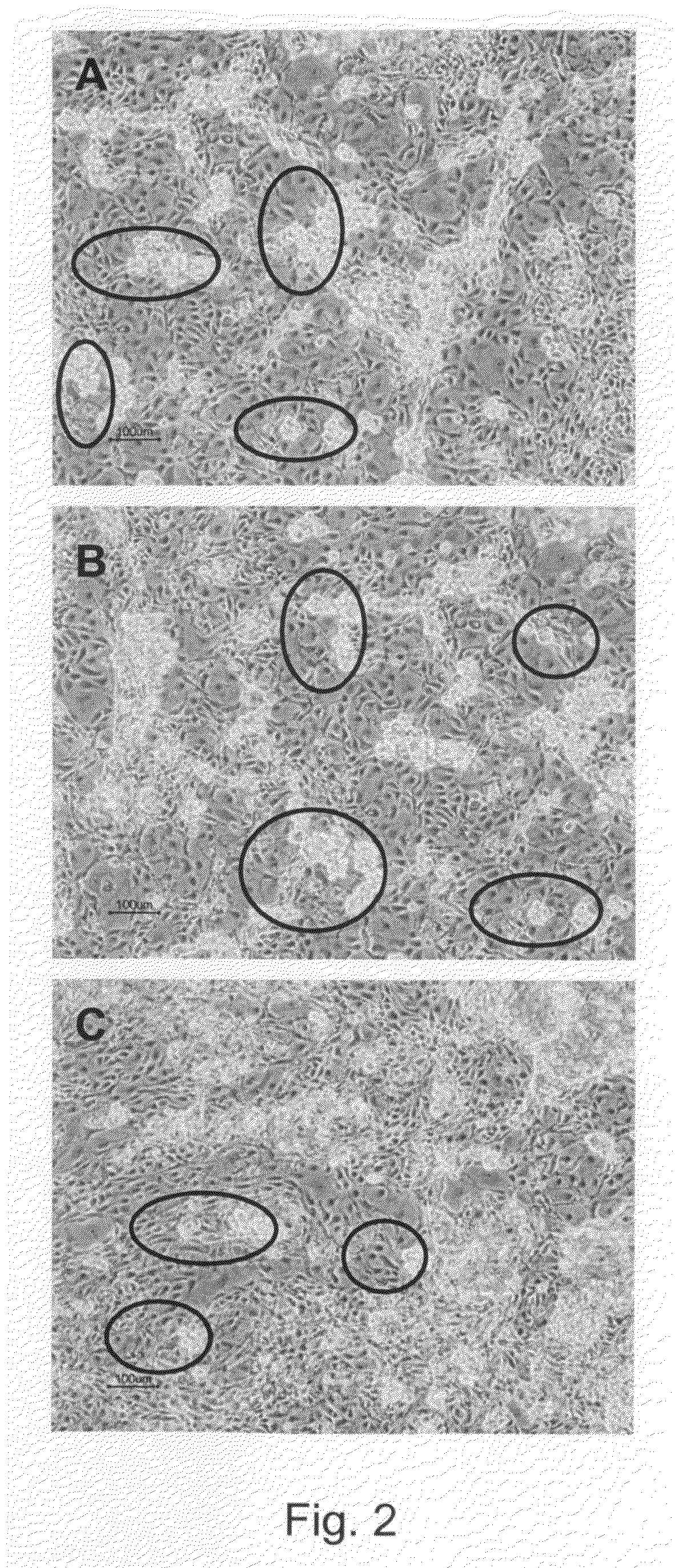Population of multipotent cardiac precursor cells derived from human blastocysts derived stem cells
a multi-potent, stem cell technology, applied in the direction of skeletal/connective tissue cells, drug compositions, immunological disorders, etc., can solve the problems of large burden on the health care system, large number of deaths, and high cost of this intervention
- Summary
- Abstract
- Description
- Claims
- Application Information
AI Technical Summary
Benefits of technology
Problems solved by technology
Method used
Image
Examples
example 1
[0300]Derivation of Basement Cells from Undifferentiated hBS Cells
[0301]Suspension Culture
[0302]Undifferentiated hBS cells were maintained and propagated in vitro. At day 4-5 after passage undifferentiated hBS cell colonies were manually dissected using a Stem Cell Cutting Tool and placed in differentiation medium (KO-DMEM supplemented with 1 mM Glutamax, 0.1 mM β-MeOH, 1% NEM, 1% PeST and 20% FBS) in suspension cultures. The cells were maintained in suspension for 1-6 days and subsequently transferred to gelatin-coated tissue culture dishes leading to adhesion of the differentiating cell clusters and continued proliferation and differentiation of the cells. Four days after plating a monolayer of cells appear from the adherent clusters of differentiating hBS cells. These cells grow in a characteristic tight network with appearance resembling a maze which makes areas of basement cells easy to distinguish using light microscopy. The morphology of the basement cells share similarities ...
example 2
[0305]Characterization of Basement Cells
[0306]Basement cells were derived from undifferentiated hBS cells as described above. They were cultured in differentiation medium (KO-DMEM supplemented with 1 mM Glutamax, 0.1 mM β-MeOH, 1% NEM, 1% PeST and 20% FBS) for up to 37 days. Cells were fixed at various time points in PFA and evaluated by immunohistochemistry (Noaksson et al Stem Cells 2005). Antigen markers used were vimentin, desmin, α-sarcomeric actin and brachyury. The basement cells expressed α-sarcomeric actin and brachyury (FIG. 9) but not vimentin and desmin. Cell lines used were SA002, LOTAL002 (passage 26), SA002.5, LOTBE002.5 (passage 32) and SA461, LOTBF461 (passage 33).
[0307]Table I summarizes the obtained results of the IHC analysis of basement cells.
[0308]
TABLE IAntigenDays ofmarkerDifferentiation*ResultAntibody infoVimentin25Negativemouse anti-vimentin antibody,V-6630, SigmaDesmin25Negativemouse anti-desmin antibody,MAB1698, Chemiconα-36Positivemouse anti-alpha sarcom...
example 3
[0311]Micro Array Analysis of Basement Cells
[0312]Cell Culture and Differentiation
[0313]The hBS line SA002 was propagated and the cells differentiated to basement cells as described above, forced aggregation, example 1. Using light microscopy clusters of basement cells were identified and mechanically isolated using a Stem Cell Tool. For comparison purposes in the micro array experiments, samples of undifferentiated hBS cells, samples from a mixed population of differentiated hBS cells (i.e., no basement cells present), and samples from spontaneously contracting cardiomyocyte-like cells derived from hBS cells (Norstrom et.al 2006, Kehat et.al. 2001) were collected and included in the analysis.
[0314]Samples:[0315]1. Undifferentiated hBS cells (passage 33, 36, 37, 39, and 40)[0316]2. Basement cells (passage 22, 23, 26-28, 32, 33, 36, and 37)[0317]3. Mixed population of differentiated hBS (passage 22, 28, and 32)[0318]4. Cardiomyocyte-like cells 1 (passage 23-25, 29, and 35)[0319]5. Ca...
PUM
| Property | Measurement | Unit |
|---|---|---|
| diameter | aaaaa | aaaaa |
| time | aaaaa | aaaaa |
| concentration | aaaaa | aaaaa |
Abstract
Description
Claims
Application Information
 Login to View More
Login to View More - R&D
- Intellectual Property
- Life Sciences
- Materials
- Tech Scout
- Unparalleled Data Quality
- Higher Quality Content
- 60% Fewer Hallucinations
Browse by: Latest US Patents, China's latest patents, Technical Efficacy Thesaurus, Application Domain, Technology Topic, Popular Technical Reports.
© 2025 PatSnap. All rights reserved.Legal|Privacy policy|Modern Slavery Act Transparency Statement|Sitemap|About US| Contact US: help@patsnap.com



